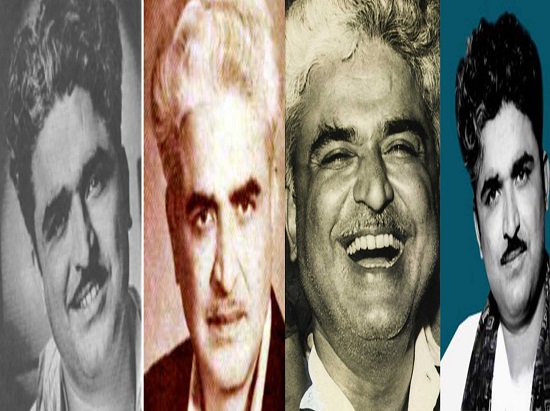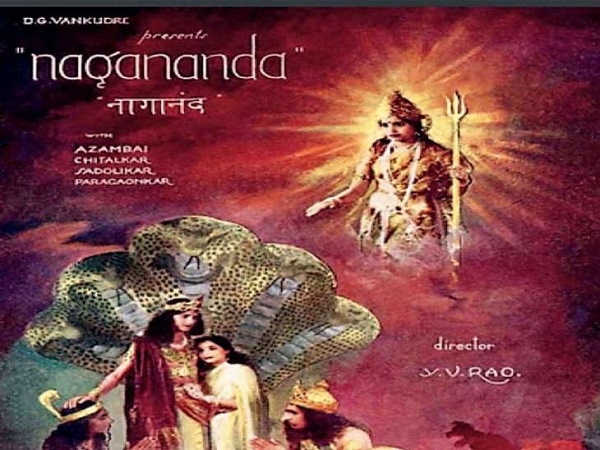Music Director C Ramchandra: The Fastest Deliveryboy of Magical Melodies
A creative genius, C. Ramchandra came to the city of dreams to become an actor, did only some cameos and vanished from the acting field. However, he continued to struggle and became a famous music director. He was a pioneer and trendsetter, whose mellifluous music left an indelible imprint on listener’s mind. He was brilliantly versatile, having composed music for peppy club songs to lullabies to ghazals and lilting love songs. His creativity, variety and flair for composing simple tunes without getting overly obsessed with classical music, reflected his flamboyant personality. He composed numerous juvenile songs depicting raucous and joyful mood, mostly picturised on the raunchy comedy team of Yakub and Gope. He gave playback as Chitalkar, while scoring music he adopted many names like Anna Sahib, Ram Chitalkar, P Ramakant, C Ramachandra and Shyamoo.
C. Ramchandra was born as Ramachandra Narhar Chitalkar in Puntambe village (Ahmednagar), on January 12, 1918 in a typical Marathi Brahmin family. As a child his ambition was to become a soldier or a musician. He was admitted in Vinayak Rao Patwardhan’s Gandharva Mahavidyalaya. He learnt classical music for six years under Sri Shankerrao Sapre. At the age of ten he played the harmonium like a prodigy. He turned out to be poor in academics and could get education upto ninth standard. Contrary to the wishes of his family, he decided to pursue his twin loves Music and Cinema.
C. Ramchandra, a devilishly handsome man with 6 feet of height and a spate of curly hair, got the role of an extra in Lalit Pictures. He played some itsy-bitsy characters with a paltry salary of Rs 50. Soon he bagged the lead role in Hindi film Naganand (1935). The film flopped as its first show had only 7 cinegoers in the audience. His subsequent films Said-e-Hawas (1936) and Atma Tarang (1937) also failed to uplift his acting career. He realised that acting was not his forte and he decided to showcase his music talent.

Sohrab Modi of Minerva Movietone was impressed with Ramchandra’s knowledge of classical music and appointed him as a harmonium accompanist. He learnt notation writing and started assisting music directors Mir Sahib, Bundu Khan and B.S.Hoogan. As an assistant to Meer Saab, he made mark in films like Meetha Zehar, Jailor and Pukar. He met Bhagwan Dada during the making of film ‘Bahadur Kisan’ and they had a lifelong bonhomie. He debuted as full-fledged music director in Tamil film ‘Jayakkodi’ and later he did ‘Vanamohini’. In 1942, he scored the music of Hindi film ‘Sukhi Jeevan’. This film flopped but his music style was appreciated and he ensconced himself in Bollywood. The famous producer Jayant Desai re-christened him as 'C.Ramchandra' while offering him to score music for his films Zaban, Bhaktraj, Lalkar, Manorama and Samrat Chandragupta. However, their collaboration ended during Tadbir (1945), as he demanded a higher remuneration. Meanwhile, he composed music for a few stunt films under the pseudonym of Anna Saheb.
His next destination was Filmistan Studio, where he scored music of 11 films, majority of these films were jubilee hits. Safar (1946) had superb music and the lilting duet 'Kabhi Yaad Karke..’ became very popular. Next film Leela (1947) had a delectable thumri 'Maine Lakhon Ke Bol..’, which inspired even maestro Naushad. He dared to jettison Ashok Kumar, who wished to sing the duet 'Hum Ko Tumahra Hi Aasra..’ (Sajan1947). This song in Mohammad Rafi’s voice became an instant hit and it spelt the end of Ashok Kumar's career as a playback singer. He replaced Master Ghulam Haider in Shehnai (1947) and his mellifluous music captivated the audience. Its song 'Maar Katar Mar Jana' in mujra style with the melodious harmony of sitar, harmonium and table, created a nationwide storm. He attained the peak of his creativity with Patanga (1949). It had nuggets like 'Dil Se Bhula Do..’; 'Jane Wale Tune..’ and the evergreen duet 'Mere Piya Gaye Rangoon'.
His musical trajectory entered the golden era with the music of Samadhi (1950). The dance number, 'Gore Gore, O Baanke Chhorey.., a direct lift from Edmundo Ros’s Chico-Chico, became a cult and chartbuster song. His musical scores for Sangeeta and Khazana films had distinctive influence of Latin American-Caribbean beats. Then he created nostalgic music of Albela (1951), displaying his wide range from the deeply soulful ‘Dhreere Se Aa Ja..’ to the rip-roaring ‘Shola Jo Bhadke..’ and a qawwali-style street song ‘Haseeno Se Mohabbat..’. The frenzied fans used to shower coins on theatre screens showing these songs. His caravan of success did not stop here, next year he gave another musical hit ‘Shin Shinaki Boobla Boo’.
After the magical success of Baiju Bawra, Naushad got the offer for scoring the music of ‘Azaad’ at a whopping fee of Rupees one lakh from a south Indian producer S.M.S. Naidu. When asked to provide the soundtrack within one month, Naushad retorted “Jenab, Yeh Koi Baniye Ki Dukaan Samjhi Hai Aapne? Ek Song Bhi Nahi Milega Aapko Tees Din Mein". Subsequently, Naidu approached young C. Ramchandra, who created canorous tunes like ‘Aplam Chaplam..’, ‘Na Bole Na Bole..’ and ‘Kitna Haseen Mausam’ in a record time. In return, he charged just one rupee extra what was offered to Naushad. Lata reckoned C.Ramchandra to be the fastest composer she ever came across.
His biggest success came with Anarkali (1953) and all its songs especially ‘Yeh Zindagi Usiki Hai..’, ‘Mujhse Mat Poochh..’, ‘Mohabbat Aisi Dhadkan Hai..’ and ‘Jaag Dard-e-Ishq Jaag..’ were acclaimed as masterpieces. He famously shafted Geeta Dutt by switching the soundtrack to a pure Lata production halfway through. Filmistan’s director Bibhuti Mitra had a nasty habit of interfering in music director’s work, which irritated C. Ramchandra. He got into argument with the producers during ‘Nastik’ and left Filmistan thereafter.

C. Ramachandra composed immortal soft and poignant melodies in Lata’s voice and both together created a unique musical history. She sang 248 songs for him and some of the popular compositions were ‘Mujh Pe Ilzam-e-Bewafai Hai..(Yasmin), Dil Se Bhula Do..(Patanga), Katate Hai Dukh Mein.. (Parchhai), Tum Kya Jaano.. (Shin Shinkai Bubalboo), Mehfil Mein Jal Uthi Shama.. (Nirala), Koi Kisi Ka Deewana.. (Sargam), Ye Zindagi Usiki Hai.. (Anarkali), O Nirdayi Pritam… (Stri) etc. She even composed music for a Marathi film, 'Ram Ram Pahune' under his tutelage. Ramachandra had knack for creating songs of patriotic fervour. He composed Allama Muhammad Iqbal’s famous song ‘Sare Jahan Acha Hindustan Hamara...’ in the film ‘Sukhi Jeevan’. His immortal composition 'Aye Mere Watan Ke Logo' moved to tears not just Pt. Jawaharlal Nehru but the entire nation.
He introduced rock 'n' roll in India before it became a rage in Europe. In 'Meri Jaan..Sunday Ke Sunday...' (Shehnai) he introduced the Benny Goodman style of jazz clarinet. His use of Western instruments with the traditional Indian instruments created an enthralling effect in fast-paced songs 'Shola Jo Bhadke..' and 'Ye Diwana Ye Parwana..' etc. He composed 'Eena Meena Deeka' (Asha), a song in scat singing style at home with his assistant John Gomes. The first part of the song was created by listening to children outside playing ‘Eeenie-Meenie-Miny-Moe’ and adding the words ‘de dai damanika’ to the tune. Gomes suggested the Konkani phrase ‘maka naka and kept adding nonsensical words until it ended with ‘rum pum po!’. And that’s how the first rock-n-roll song in Hindi cinema was created.
Chitalkar was endowed with a pleasant voice and he sang in the middle octave. Many of his light-hearted/fun songs were intrinsically melodious. He has sung in films like Jhamela, Sargam, Nadiya Ke Paar, Khazana, Sagai, Sanwariya, Shin Shinaki Boobla Boo, Sharda, Shagufta etc. He gave playback for the great trinity Raj Kapoor (Sargam), Dilip Kumar (Azaad) and Dev Anand (Barish), displaying his prowess as a playback singer.
A staunch devotee of Shri Sai Baba, C. Ramachandra launched his production company “New Sai Productions” in collaboration with comedian Om Prakash. Under this banner, he produced three films Jhanjhar, Lehren and Duniya Gol Hai. He also produced two Marathi movies Dhananjay and Gharkul. He had set-up an Academy of Indian Music. He wrote his autobiography ‘Mere Jeevan Ki Sargam’ in Marathi in 1977.
The artesian well of Ramchandra's creativity had run dry by the early 1960's and 'Rootha Na Karo' (1970) was his last Hindi film. During his illustrious career, he gave music in 112 films of Hindi, Marathi, Telugu, Tamil, and Bhojpuri languages. He was conveniently forgotten by the film-fraternity and the Government. These things deeply hurt C Ramchandra, and eventually he too turned to alcohol to forget and forgive.
He had been suffering from ulcers and passed away on 5 January 1982. A Melody was over forever….!
“Tum Kya Jano, Tumhari Yaad mein Hum Kitna Roye..”
-

-
Bhim Raj Garg, Blogger
gbraj1950@gmail.com
Phone No. : 09876545157
Disclaimer : The opinions expressed within this article are the personal opinions of the writer/author. The facts and opinions appearing in the article do not reflect the views of Babushahi.com or Tirchhi Nazar Media. Babushahi.com or Tirchhi Nazar Media does not assume any responsibility or liability for the same.